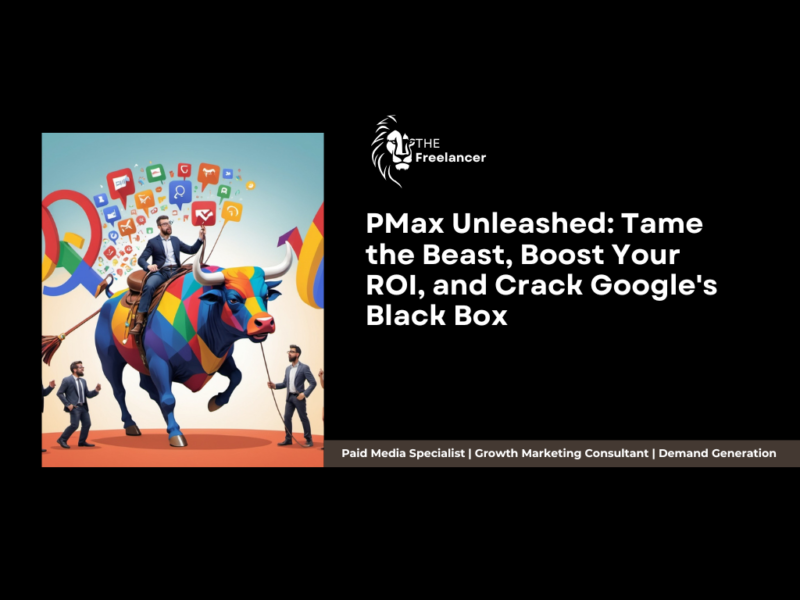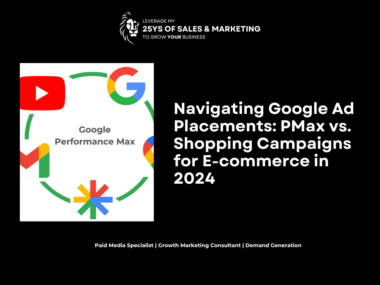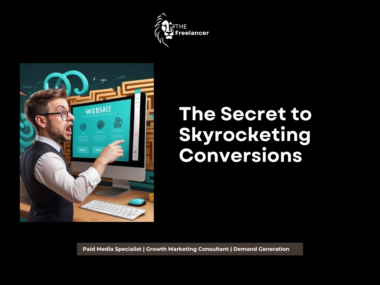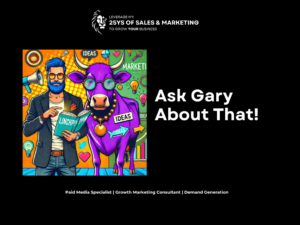Welcome, brave digital marketers, to the wild and wacky world of Performance Max campaigns! If you’ve found yourself scratching your head, wondering if Google’s latest advertising brainchild is a stroke of genius or just another way to confuse the living daylights out of us, you’re not alone. Fear not, for we’re about to embark on a journey through the PMax jungle, armed with nothing but our wits, a sense of humor, and an unhealthy addiction to caffeine.
In this guide, we’ll explore the ins and outs of Performance Max campaigns, from deciding whether to take the plunge, to optimising your campaigns like a pro, and finally, to unraveling the mystery of where your precious ad dollars are actually going. So buckle up, buttercup – it’s going to be a wild ride!
What in the World is Performance Max?
Before we dive headfirst into the deep end, let’s take a moment to understand what Performance Max (PMax) actually is. Imagine if Google took all of its advertising platforms, threw them into a blender, added a dash of AI, and sprinkled in some automation magic. The result? Performance Max campaigns.
In essence, PMax is Google’s way of saying, “Hey, you know all those campaigns you’ve been meticulously managing? Yeah, how about we just throw them all together and let the machines handle it?” It’s like having a robot assistant who’s really enthusiastic but sometimes forgets to tell you what it’s doing.
Key Features of PMax:
1. Cross-channel reach: Your ads can appear across Google’s entire advertising ecosystem (Search, Display, YouTube, Gmail, and Discover). It’s like being everywhere at once, without the need for a time-turner or cloning technology.
2. Automated bidding and ad placement: Google’s AI decides where and when to show your ads. It’s like having a very opinionated media buyer who doesn’t need sleep or coffee breaks.
3. Asset-based approach: Instead of creating specific ads for each platform, you provide a bunch of assets (images, videos, text), and Google mixes and matches them like a overzealous DJ at a wedding.
4. Goal-based: You tell Google what you want (more sales, leads, etc.), and it goes off to make it happen. It’s like making a wish, except instead of a genie, you get a very complex algorithm.
To PMax or Not to PMax? That is the Question
Now that we know what this PMax beast is, let’s figure out if it’s right for you. It’s like deciding whether to get a pet tiger – exciting, but potentially dangerous if you’re not prepared.
Pros of PMax:
1. Reach: You can potentially reach customers across all of Google’s platforms with a single campaign. It’s like casting the widest net possible, without having to, you know, actually cast multiple nets.
2. Automation: Less time spent on manual optimisations means more time for important things, like figuring out why your office plant keeps dying despite your best efforts.
3. Machine Learning: Google’s AI can potentially find opportunities you might have missed. It’s like having a super-smart intern who works 24/7 and never asks for a raise.
Cons of PMax:
1. Less Control: You have limited say in where your ads show up. It’s like telling your GPS “I want to go somewhere nice” and ending up at a gas station in the middle of nowhere.
2. Reduced Visibility: You get less detailed data about performance. It’s a bit like flying a plane with half the instruments covered up – exciting, but potentially terrifying.
3. Potential Cannibalisation: PMax might compete with your other campaigns. Imagine your ad campaigns as siblings fighting for attention – PMax is the overachiever who hogs the spotlight.
When to Consider PMax:
– You have a solid conversion tracking setup. If you don’t, it’s like trying to bake a cake without knowing if your oven is actually on.
– Your business has diverse product offerings. The more variety, the merrier!
– You’re looking to expand reach across multiple channels without managing separate campaigns.
When to Avoid PMax:
– You need granular control over keywords and placements. If you’re a control freak (no judgment), PMax might give you anxiety.
– Your conversion volume is low (less than 30 conversions per month). PMax needs data like plants need water – without enough, it’ll wither.
– You rely heavily on search term data for optimisation. If search terms are your bread and butter, PMax might leave you feeling a bit hungry.
Optimising Your PMax Campaigns (Or: How to Tame the Beast)
So, you’ve decided to take the plunge into the PMax pool. Congratulations! Now, let’s talk about how to keep your head above water and maybe even do a few impressive strokes while we’re at it.
a) Asset Optimisation: Feeding the Beast
Remember how we said PMax is like a DJ mixing your assets? Well, it’s time to give that DJ some killer tracks to work with. Here’s how:
1. Create multiple asset groups: Think of these as different playlists for different moods or occasions. You might have one for your bestsellers, another for seasonal products, and maybe one for those weird items that only sell on full moons.
2. Use a variety of high-quality images and videos: The more, the merrier! Give Google plenty to work with. It’s like going to a potluck – the more dishes you bring, the higher the chance something will be a hit.
3. Write compelling headlines and descriptions: These are your pickup lines in the dating world of advertising. Make them snappy, relevant, and irresistible.
4. Regularly refresh your assets: Keep things fresh! Nobody likes a stale sandwich, and nobody clicks on stale ads either.
Pro Tip: Use Google’s Asset Report to see which of your assets are performing well. It’s like getting a report card for your ads – hopefully with fewer F’s than your high school algebra class.
b) Audience Signals: Sending Out the Bat Signal
Audience signals are like leaving a trail of breadcrumbs for Google’s AI to follow. Here’s how to make sure those breadcrumbs lead somewhere good:
1. Leverage first-party data: Use Customer Match lists to target people who already know and (hopefully) love you. It’s like inviting your friends to a party – they’re more likely to show up and have a good time.
2. Use custom segments: Create audiences based on website visitors or app users. These are the people who’ve shown interest but haven’t committed yet – like that person who keeps looking at your dating profile but hasn’t swiped right.
3. Experiment with in-market and affinity audiences: These are people who are either actively looking for products like yours (in-market) or have shown a general interest in your industry (affinity). It’s like finding people who are already at the mall versus those who just like shopping in general.
c) Product Feed Optimisation: Making Your Products Look Sexy
If you’re using PMax for ecommerce, your product feed is like your store window display. Make it shine!
1. Keep your feed up-to-date: Nothing’s worse than advertising a product that’s out of stock. It’s like inviting someone over for dinner and then ordering pizza because you forgot to go grocery shopping.
2. Use custom labels: These are like secret codes that help you group products strategically. You could have labels for bestsellers, high-margin items, or seasonal products.
3. Optimise product titles and descriptions: Make them clear, compelling, and keyword-rich. It’s like giving your products their own mini elevator pitches.
d) Conversion Tracking: Making Sure the Cookie Crumbles in Your Favour
Proper conversion tracking is the foundation of any successful PMax campaign. Without it, you’re basically throwing darts in the dark and hoping you hit something valuable.
1. Implement robust conversion tracking: Track not just sales, but also micro-conversions like email sign-ups or add-to-carts. It’s like keeping score in a game – the more points you track, the better you understand how you’re doing.
2. Use value-based bidding: Assign different values to different conversion actions. Not all conversions are created equal – a newsletter signup isn’t worth the same as a £1000 purchase (unless you have a really, really good newsletter).
3. Consider implementing enhanced conversions: This helps improve the accuracy of your conversion measurement. It’s like upgrading from a regular scale to one of those fancy body composition analysers – you get a more detailed picture of what’s going on.
e) Budget and Bidding: Show Me the Money!
Now, let’s talk about everyone’s favourite topic – money! Here’s how to make sure your budget is working as hard as you do:
1. Start with Maximise Conversions: This bidding strategy tells Google to get you as many conversions as possible within your budget. It’s like telling a kid in a candy store to get as much candy as they can with $5 – they’ll find a way!
2. Transition to Target ROAS or Target CPA: Once you have enough data (usually after about 15-30 days), you can switch to these more advanced strategies. It’s like graduating from a tricycle to a bicycle – a bit scary at first, but ultimately more efficient.
3. Allocate budget based on performance: Give more money to the campaigns that are performing well. It’s like watering the plants that are actually growing, instead of that cactus that’s been suspiciously immobile for months.
Gaining Visibility into PMax Spend (Or: Where Did All My Money Go?)
One of the biggest challenges with PMax is the lack of granular data. It’s like trying to track your teenager’s spending – you know the money’s gone, but the details are fuzzy. Here are some strategies to gain more visibility:
a) Utilise the Insights Page: Your Window into the PMax Soul
The Insights page is like PMax’s diary – it won’t tell you everything, but it’ll give you some juicy tidbits:
1. Regularly check for performance breakdowns by channel: Find out if your ads are killing it on YouTube but bombing on Gmail.
2. Analyse top-performing assets and audience segments: Discover what’s working and do more of that. It’s like finding out which of your jokes actually make people laugh (and which ones make them cringe).
b) Implement UTM Parameters: The Breadcrumb Trail
UTM parameters are like little tags you attach to your URLs. They help you track where your traffic is coming from in Google Analytics.
1. Use UTM parameters in your final URLs: This allows you to see PMax performance in Google Analytics.
2. Create custom channel groupings in GA: Separate PMax traffic from your other campaigns. It’s like having a separate piggy bank for your PMax coins.
c) Leverage the Asset Group Report: Your Ad’s Report Card
This report shows you how different asset groups are performing. It’s like getting a report card for each of your ad “students”:
1. Access the Asset Group report regularly: See which groups are the star pupils and which need some extra tutoring.
2. Use this data to inform your creative strategy and budget allocation: Put more effort (and money) into what’s working.
d) Explore the Placement Report: The “Where’s Waldo?” of Ad Placements
While limited, the Placement report can give you some insights into where your ads are showing:
1. Use this data to identify and exclude poor-performing placements: If your ads are showing up on “CrazyCatLady.com” and not converting, maybe it’s time to say goodbye.
2. Look for patterns in high-performing placements: Maybe your ads are crushing it on mobile game apps – that’s good to know!
e) Utilise Scripts and Third-Party Tools: Calling in the Reinforcements
Sometimes, you need to bring in the big guns:
1. Implement Google Ads scripts: These are like little robots you can program to extract data and perform tasks automatically.
2. Consider third-party tools: There are tools out there that specialise in enhanced reporting for PMax campaigns. It’s like hiring a private detective to follow your ads around.
f) Create Experiments: Become a Mad Scientist
Why not do some A/B testing? Create campaign experiments to test different strategies:
1. Use campaign experiments to test different asset combinations: Maybe video A works better with headline B. You won’t know unless you test!
2. Compare PMax performance against traditional campaign types: Is PMax really all it’s cracked up to be? Only one way to find out!
Advanced PMax Techniques (For Those Who Like to Live Dangerously)
Ready to take your PMax game to the next level? Here are some advanced techniques for the brave and the bold:
a) Performance Planner: Your Crystal Ball
The Performance Planner is like having a fortune teller for your PMax campaigns, except it uses data instead of a crystal ball.
Where to find it:
– Log into your Google Ads account
– Click on “Tools & Settings” in the top navigation
– Under “Planning,” select “Performance Planner”
What it does:
– Forecasts performance based on different budget scenarios
– Identifies opportunities for growth
– Helps optimise budget allocation across campaigns
How to use it:
1. Create a plan that includes your PMax campaigns
2. Play around with different budget allocations
3. See how changes might affect your key metrics
Pro tip: Use the Performance Planner in conjunction with your business goals and historical data. It’s smart, but it’s not psychic!
b) Offline Conversion Tracking: Bridging the Online-Offline Gap
For businesses with significant offline sales, implementing offline conversion tracking can be a game-changer:
1. Set up offline conversion imports in Google Ads
2. Ensure your CRM data is properly mapped to Google Click IDs
3. Regularly import offline conversion data
Why bother? It gives you a more complete picture of your customer’s journey. It’s like finally finding out what happened after “happily ever after” in fairy tales.
c) Data-Driven Attribution: Giving Credit Where Credit is Due
Enable data-driven attribution (DDA) for your conversions to take full advantage of auction-time bidding:
1. Go to Tools & Settings > Measurement > Conversions
2. Select your conversion action and change the attribution model to “Data-driven”
Why it matters: DDA provides a more nuanced view of the customer journey. It’s like giving a fair performance review to all your marketing touchpoints, not just the last one that showed up to work.
d) Smart Bidding Portfolio Strategies: The Ensemble Cast
If you’re running multiple PMax campaigns, consider using portfolio bid strategies:
1. Go to Tools & Settings > Shared Library > Bid Strategies
2. Create a new portfolio strategy or modify an existing one
Benefits:
– Balances performance across multiple campaigns
– Allows for more efficient budget allocation
– Can help manage overall ROAS or CPA goals across campaigns
It’s like being the conductor of an orchestra instead of just playing one instrument really well.
e) Seasonality Adjustments: Preparing for the Weather
For businesses with predictable seasonal fluctuations, use seasonality adjustments:
1. Find this under Tools & Settings > Bid Strategies > Advanced Controls
2. Set up adjustments for known periods of increased or decreased conversion rates
Why it’s important: It helps the algorithm adapt to expected performance changes. It’s like giving your PMax campaigns a heads up that bathing suit season is coming, so they should probably lay off the cookies.
Conclusion: The PMax Adventure Continues
Congratulations, intrepid marketer! You’ve made it through the PMax jungle, armed with knowledge, strategies, and hopefully, a few chuckles along the way. Remember, mastering Performance Max campaigns is a journey, not a destination. It’s like trying to nail jelly to a wall – frustrating at times, but oddly satisfying when you get it right.
As you venture forth into the brave new world of PMax, remember these key takeaways:
1. PMax isn’t for everyone, but when it works, it can work wonders.
2. Feed the beast with high-quality, diverse assets.
3. Use audience signals to point Google in the right direction.
4. Keep a close eye on performance with the tools available.
5. Don’t be afraid to experiment and try advanced techniques.
And most importantly, don’t forget to laugh along the way. After all, if we can’t find humor in the ever-changing world of digital marketing, we might as well go back to advertising on stone tablets.
Now go forth and PMax with confidence! May your conversions be plentiful, your ROAS be high, and your coffee cup never be empty. Happy advertising!









